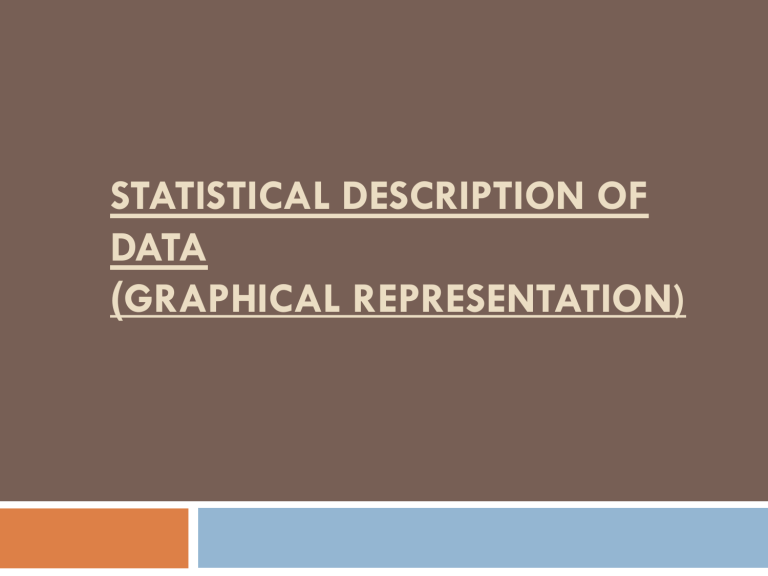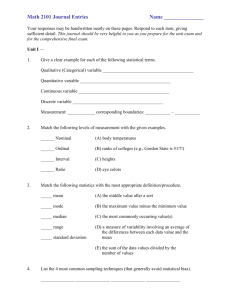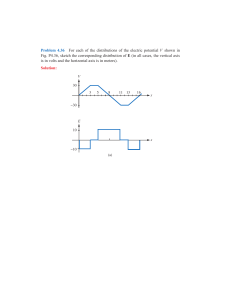
STATISTICAL DESCRIPTION OF DATA (GRAPHICAL REPRESENTATION) Introduction: Graphical representation is a way of analyzing numerical data. The visual display of statistical data in the form of lines, points and other geometrical form and symbols, is in the most general terms known as Graphical Representation. Such visual representation can be divided into two main groups: Difference b/w Graphs and Diagrams: Diagrams Graphs •are use for categorical/ nominal data. •use for quantitative data. •can be drawn on an ordinary paper. •always drawn on graph paper. •Use only for comparisons. •Use to study relationship between variables. •Data are represented by bars, rectangles, circles or other geometrical shapes. •Data are represented by dots, straight lines or curves. •e.g: Bar chart. •e.g: Histogram, Frequency Polygon 1. Bar Chart: It shows the frequency counts of values for the different levels of categorical variable. The bars show the level of variable and the height of the bars show the counts of response for that level. Bar chart may be: Simple Bar Chart Multiple Bar Chart Component Bar Chart Simple Bar Chart: A simple bar chart consists of horizontal or vertical bars of equal widths and lengths proportional to the value they represent. Multiple Bar Chart: It shows two or more characteristics corresponding to the values of common variable in the form of grouped bars, whose lengths are proportional to the values. Component Bar Chart: also known as sub-divided bar chart. is an effective technique in which each bar is divided into two or more sections, proportional in size to the component parts of a total being displayed by each bar. 14 12 10 8 Series 3 Series 2 Series 1 6 4 2 0 Category 1 Category 2 Category 3 Category 4 How to construct Bar Graph? First, decide the title of the bar graph. Draw the horizontal axis and vertical axis. Label the horizontal axis. Write the names/categories on the horizontal axis. Label the vertical axis. Finalize the scale range for the given data. Finally, draw the bar graph that should represent each category with their respective numbers. Examples: In a firm of 400 employees, the percentage of monthly salary saved by each employee is given in the following table. Represent it through a bar graph. A cosmetic company manufactures 4 different shades of lipstick. The sale for 5 months is shown in the table. Represent it using bar charts. Month Sales Shade 1 Shade 2 Shade 3 Shade 4 January 45 60 44 45 February 70 54 56 54 March 39 89 97 77 April 55 76 90 89 May 32 78 43 78 A school conducted a survey to know the favorite sports of the students. The table below shows the results of this survey: Following data gives the birth rates and death rates per thousand of a few countries. Represent them by multiple bar chart: Country Birth Rates Death Rates India 33 24 Japan 32 19 Germany 16 10 Egypt 44 24 Australia 20 9 New Zealand 18 8 France 21 16 2. Histogram: Histogram: a graphical display of data using bars of different heights. A histogram consists of a set of adjacent rectangles whose bases are marked off by class boundaries on the X-axis and whose height are proportional to the frequencies associated with respective classes. How do you make a histogram? To make a histogram, follow these steps: On the vertical axis, place frequencies. Label this axis "Frequency/ f". On the horizontal axis, place the lower value of each interval or class boundaries. Draw a bar extending from the lower value of each interval to the lower value of the next interval. Examples: 1: Construct a histogram for the following frequency distribution of the heights of 100 male students at college. Height 60 -- 62 63 -- 65 66 -- 68 69 --71 72 –74 Num of students 5 18 42 27 8 Difference b/w Bar Chart and Histogram: 3. Frequency Polygon: Frequency polygons are a visually substantial method of representing quantitative data and its frequencies A frequency polygon is a graph constructed by using lines to join the midpoints of each interval, or bin. The heights of the points represent the frequencies. Steps to Draw Frequency Polygon Mark the mid values/ class mark on the horizontal axis. Mark the frequency of the class on the vertical axis. Corresponding to the frequency of each mid value, mark a point at the height. Connect these points using the line segment. Example: Construct a frequency polygon for the following data: Classes 20--24 25-29 30--39 40--44 45--49 50--54 55—64 f 1 26 20 15 14 2 22





